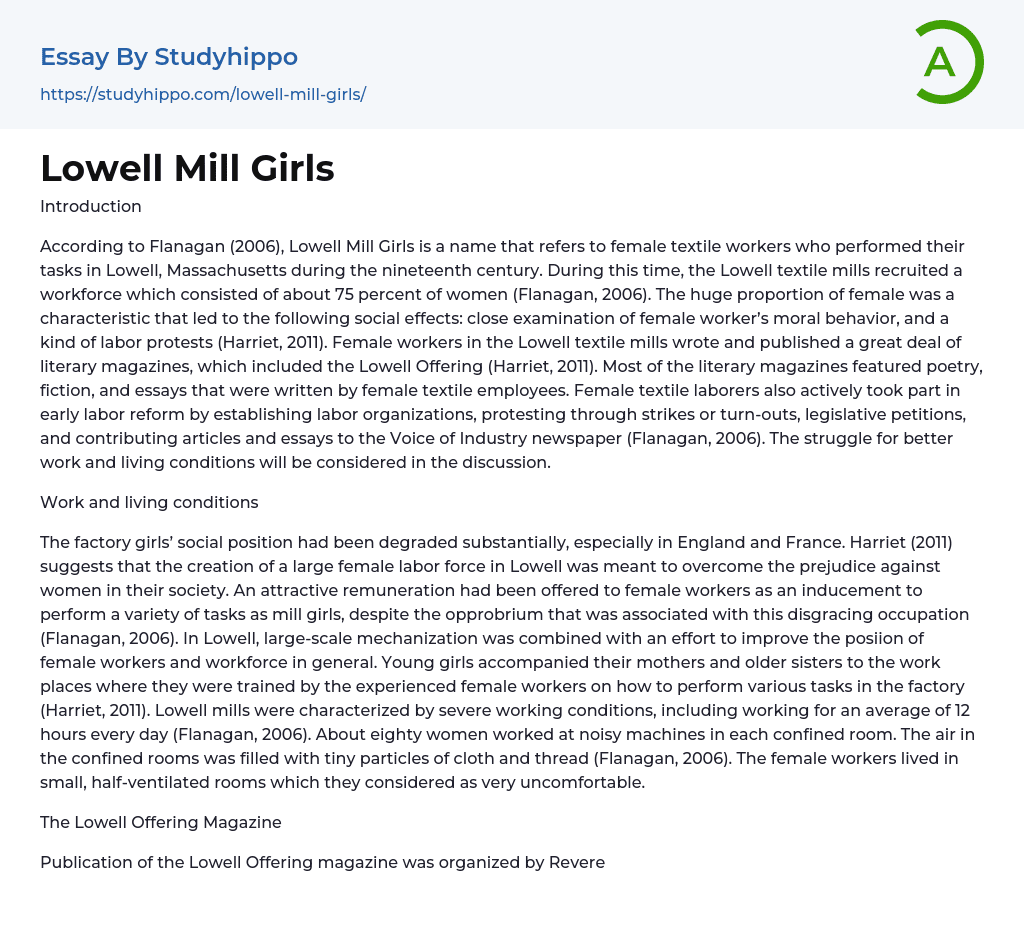According to Flanagan (2006), the term "Lowell Mill Girls" refers to female textile workers in Lowell, Massachusetts during the 19th century. During this time, about 75 percent of the workforce in the Lowell textile mills were women. This high proportion of female workers had significant social effects, such as increased scrutiny of their moral behavior and labor protests (Harriet, 2011). Female workers in these mills also produced literary magazines, including the Lowell Offering, featuring poetry, fiction, and essays written by female textile employees. These women actively participated in labor reform by establishing organizations, going on strikes or turn-outs, submitting legislative petitions, and contributing to the Voice of Industry newspaper (Flanagan, 2006). This discussion will explore the struggle for improved work and living conditions. The creation of a large female labor force in Lowell aimed to challenge societal prejudice agains
...t women (Harriet, 2011).An attractive remuneration was offered to female workers as an inducement to perform various tasks as mill girls, despite the opprobrium associated with this disgracing occupation (Flanagan, 2006). In Lowell, large-scale mechanization was combined with efforts to improve the position of female workers and the workforce in general. Young girls would accompany their mothers and older sisters to the workplace, where experienced female workers would train them in various factory tasks (Harriet, 2011).
The Lowell mills had severe working conditions, with workers averaging 12-hour days (Flanagan, 2006). Each confined room housed about eighty women working at noisy machines. These rooms were filled with tiny particles of cloth and thread (Flanagan, 2006). The female workers lived in uncomfortable, small, and poorly ventilated rooms.
Reverend Abel Charles Thomas organized the publication of the Lowell Offering magazine in 184
(Harriet, 2011). As the magazine grew more popular, women started contributing fiction, essays, poems, and ballads (Flanagan, 2006). Through their literary works, women used characters to report on their life situations and conditions. The Lowell Offering featured both farcical and serious content (Harriet, 2011).Initially in 1834, female workers received good wages from their employers. However, due to economic depression, the Board of Directors proposed a 15 percent reduction in pay. In response, the female workers protested through strikes and turn-outs. Some women even withdrew their savings, causing a local bank crisis. Despite their efforts, the protest was unsuccessful and the workers returned to their jobs with lower wages. The strike demonstrated the determination of the Lowell female workers to engage in labor action. In 1836, another strike was organized when the Board of Directors suggested raising rent for workers living in boarding houses. After the strike, the rent hike was officially cancelled. Then, in 1845, the Lowell female textile employees established the Lowell Female Labor Reform Association to advocate for better working conditions, improved living quarters, and shorter work hours. As part of their efforts, the association published the Voice of Industry newspaper.The organizing efforts of the Lowell girls were notable for their political framework, which aimed to appeal to the public. They framed their struggle for better pay and shorter work days as a matter of personal dignity and rights. To emphasize their cause, they aligned themselves with the context of the American Revolution (Harriet, 2011). This large female labor force in Lowell was intended to challenge the prejudice against women in their society (Harriet, 2011). However, the female workers faced various problems such
as reduced wages, poor living conditions, higher rent, and long work days (Flanagan, 2006). These challenges compelled the women to organize protests through strikes or turn-outs as a means of asserting their rights. Additionally, they expressed their thoughts and emotions through literary works including fiction, essays, poems, and ballads (Flanagan, 2006).
- Culture essays
- Social Control essays
- Citizenship essays
- Social Justice essays
- Caste System essays
- Social Responsibility essays
- Socialization essays
- Deviance essays
- Modern Society essays
- Popularity essays
- Civil Society essays
- Community essays
- Female essays
- Filipino People essays
- Igbo People essays
- Indigenous Australians essays
- Indigenous Peoples essays
- Minority Group essays
- Social Institution essays
- Men essays
- The nation essays
- Middle Class essays
- Social Norms essays
- Discourse Community essays
- Popular Culture essays
- Car Culture essays
- American Culture essays
- Mormon essays
- Indian Culture essays
- Mexican Culture essays
- Pop Culture essays
- Cultural Differences essays
- Culture Shock essays
- Different Cultures essays
- Profession essays
- Labour Economics essays
- Occupational Safety And Health essays
- Pension essays
- Salary essays
- Strike Action essays
- Wage essays
- Career essays
- Workplace essays
- Homeless essays
- Working Together essays
- Career Path essays
- Hunter essays
- Farmer essays
- Nurse essays
- Pilot essays




